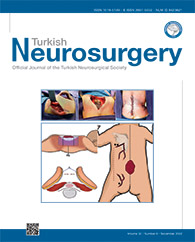2All India Institute of Medical Sciences, Department of Anatomy, Rishikesh, India
3Tulane University School of Medicine, Director of Surgical Anatomy, Program Director of Anatomical Research, Clinical Neuroscience Research Center Professor, Departments of Neurosurgery, Neurology, Surgery, and Structural and Cellular Biology Tulane, New Orleans, LA 70112, USA
4All India Institute of Medical Sciences, Department of Radiodiagnosis, Rishikesh, India
5All India Institute of Medical Sciences, Department of Anatomy, Patna, India DOI : 10.5137/1019-5149.JTN.36551-21.2 AIM: To determine the prevalence, location, and dimensions of interthalamic adhesions (ITAs) in Indian brains.
MATERIAL and METHODS: We examined 100 human brains [50 cadaveric and 50 magnetic resonance (MR) images] in the midsagittal plane for the presence or absence of ITAs, their location in the lateral wall of the third ventricle and dimensions.
RESULTS: ITA was found in 87 brains (87%), four showed duplication (4%). Both its duplication and absence were more frequent among males than in females. It was most commonly located in the anterosuperior quadrant with posterosuperior extension. The mean horizontal diameter (7.13 ± 4.31 mm) was longer than the vertical (5.13 ± 3.17) in all the brains. Its average area (37.98 ± 41.47 mm2) showed tremendous variation (ranges between 4.40 mm2 to 203 mm2) and was significantly higher in females (61.23 ± 56.22 mm2) than males (36.44 ± 43.21 mm2) (p=0.026). No correlation was found between the surface area of the ITA and the length of the third ventricle.
CONCLUSION: Absence and duplication of ITA are fairly common in Indian brains with significant male predominance. Morphometric data are robust to advocate for sex differences in the ITA size, although not associated with surrounding thalamic or third ventricle anatomy.
Keywords : Brain, Cadaver, Histological Techniques, Neuroanatomy, Schizophrenia, Thalamus, Third Ventricle




